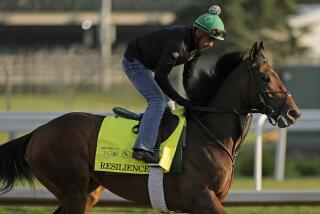Blind Faith : Trainer Takes Sightless Horse on a Trail of Trust
- Share via
This is a story about a horse and her man.
The horse is named Lady Moonlighter. The man is named Kermit Samples. He doesn’t own Lady Moonlighter; it’s more the other way around. Sometimes he calls her “Bella.”
Bella, he explains, is Italian for beautiful.
She’s a big, strong mare. The color is a light dappled gray or, maybe, as Kermit puts it, “a moonlight white.” She stands at 16 hands and people who know horses remark on her “lines,” her “conformation.” There is a dignity, a majesty, in her bearing. She’s 7 years old. Used to be a brood mare. One of her offspring, it is said, runs and wins at Los Alamitos. Good genes.
Lady Moonlighter would be a remarkable horse even if she weren’t blind. Take a good look and you will see there are no irises in her liquid blue eyes. And this is why, when Kermit first introduced me to Lady Moonlighter, she bumped her head against the metal bars of her pen.
“Oh, I’m sorry,” Kermit said, stroking her. “I should have warned you.”
The impulse is to feel pity--to think, oh, poor thing. But if not for her blindness, Lady Moonlighter would have never met Kermit Samples. Indeed, had she not been blind, this horse, like so many others, would have been sold for slaughter and served up as dinner in France or maybe Japan.
Americans don’t eat horse meat. Jeri Lerner, the editor of Animal Voice magazine, suggests that this cultural taboo reflects the prominent role that the horse played in settling this land. The most ardent animal rights’ activists object to the eating of meat and the wearing of leather on moral grounds. Lerner is one such person; that’s another reason Lady Moonlighter lives.
Lerner and Animal Voice publisher Laura Moretti are soldiers in a movement that, in their words, “rescues” horses bound for slaughter. According to Lerner, 250,000 horses are fattened up and slaughtered each year. Activists such as Lerner and Moretti don’t break into the feedlots and liberate the animals. They simply outbid the meat dealers.
Lerner and Moretti were on such a mission at a Chino feedlot last spring when they spotted the big, beautiful horse. The horse’s manner suggested there was something different. When they realized this mare was blind, Lerner says, “we just had a problem with this horse loaded on a livestock truck and suffering the horror of the slaughterhouse.”
Now, this type of horse dealing involves tricky moral decisions. There’s a lot of meat on Lady Moonlighter’s bones, so she didn’t come cheap. The price was $900. For a little more money, perhaps two horses could have been spared. Still, they decided to save Lady Moonlighter.
“This may sound silly,” Lerner says, “but sometimes it’s sort of the horse picks you.”
Kermit Samples understands the feeling. He’s a modern cowboy, a horse trainer by profession. Grew up on his grandfather’s ranch in Texas. Learned about horsemanship from his grandpa, who was part Comanche. Today, Kermit Samples, 45, counts himself among the new wave of horse trainers who shun the old cowboy method of “breaking” horses by force and intimidation. They “gentle” horses, patiently winning their trust. Some old cowboys think of it as touchy-feely, New Age stuff. Kermit says he’s just building on his grandpa’s knowledge.
He calls his business GPH Inner Horsemanship. The GPH stands for “Grandpa’s Hands.”
In the summer, Kermit’s work took him to the JR Ranch in the rugged hills above Chatsworth. He saw the beautiful white horse and heard her story. It didn’t seem right that this horse would be rescued only to be placed in a metal pen. She seemed frightened by her surroundings. One time, Lady Moonlighter became so tangled in the bars that she, trying to free herself, cut herself and uprooted part of her pen.
Lerner and Moretti had misgivings of their own. “Laura said, ‘Jeri, we rescued her, but what kind of life does she really have?’ ”
Kermit was taken with Lady Moonlighter. The idea of working with a blind horse was a challenge, but, he says, there was an emotional connection as well. He wanted her to have a better life. And he figured Lady Moonlighter could teach him things beyond the powers of sighted horses.
Kermit brought Lady Moonlighter out of her pen. For him it was a labor of love, all volunteer. They worked together hour after hour, day after day.
One day, Lerner says, Moretti dropped by the ranch. “Kermit said, ‘Let me show you something.’ ”
He took Lady Moonlighter out of the pipe corral and led her to her rescuers. Then Kermit said, “You know Laura, don’t you?”
Lady Moonlighter nodded yes. To another question, she shook her head no. Then, reacting to Kermit’s voice cues, the horse stepped toward Laura. On another, Lady Moonlighter took several steps backward. Sighted horses don’t like taking more than two steps backward.
He took Lady Moonlighter out of reverse and had her trot around the ring. Then he saddled and rode her. Kermit figures that she’d probably never been ridden in her seven years.
Moretti and Lerner were in tears. They urged Kermit to continue his work. “The bond between these two,” Lerner says, “is just incredible.”
Lady Moonlighter trusts Kermit to serve as her eyes. Now she pulls him in a carriage.
Today marks a kind of coming-out party for Lady Moonlighter. This horse that seemed destined to be butchered and served as an entree in foreign lands is scheduled to appear with Kermit in the Chatsworth Holiday Parade. The pageant, sponsored by the Chatsworth Chamber of Commerce, starts at 1 p.m., beginning at Devonshire Street and Jordan Avenue and ending at Mason Park.
Kermit has come up with a theme for Lady Moonlighter’s role in the parade. He wants to put a sign on the carriage.
“Seeing,” it would say, “is from the heart.”
More to Read
Sign up for Essential California
The most important California stories and recommendations in your inbox every morning.
You may occasionally receive promotional content from the Los Angeles Times.










